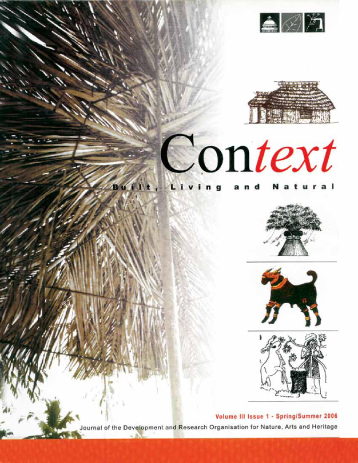Volume III Issue 1
Editorial
How often do we go beyond the mere recording of the physical and the social context to inquire into the human, anthropological angle? How often do we attempt to understand and interpret the indigenous ways of living, constructing and conserving? As trained professionals, do we ever question the existing methodologies for documentation and conservation or try to evolve new ones?
This issue brings forth relevant questions about our present methodologies for documentation and conservation of heritage. It presents anthropological perspectives - people and their rituals, their reverence for nature, the indigenous solutions to conserve their surroundings and the various representations of their beliefs.
Nold Egenter debates the very basis of existing documentation and presentation of architectural history - and introduces an anthropological framework to study architecture focusing on evolutionary aspects of human beings as opposed to the existing one on subjective, aesthetic values. The article on Malaji’s hill by Bhoju Ram Gujar and Ann Grodzins Gold expresses similar views about conservation. It shows that indigenous communities devise their own methods often rooted in traditional beliefs to preserve their surrounding environment. In contrast, and further emphasising the urban-rural dichotomy, Jyotsna Bapat and Joep Verhagen discuss the challenges faced in a World Bank funded conservation project for the water bodies in Hyderabad. Their article Blue Green Hyderabad highlights the failure of planned community participation in conserving heritage in an urban setting. The message in the above two examples is loud and clear - the solution for sustainable conservation lies within. Traditional societies often generate their own rules of survival and the real training of professionals is probably through studying such cases.
The heritage albums on Mata ni Pachedi and Chamba festival as well as the book review again emphasise the significance of intangible cultural heritage. After a comprehensive evaluation of the policies for conserving built heritage in our earlier issues, this time, we present the views of expert environmentalists Vandana Shiva and Sunita Narain on different aspects of the MOEF’s National Environment Policy.
Shikha Jain
Contents
Editorial
Compiling Records
Mansions of Chettinad, South India
Kamalahasan Ramaswamy
Anthropology of Habitat and Architecture
Nold Egenter
Methods and Approaches
Malaji’s Hill: Divine Sanction, Community Action
Bhoju Ram Gujar and Ann Grodzins Gold
Medicinal Plants of Himachal Pradesh - A Natural Heritage
Vipan Guleria
Amarnath Yatra Trail : Identification of Problems and Recommendations
R.L.Bawa
Building with Local Resources
Jigna Desai and Sanjay Chickermane
Sustainable Solutions
Blue Green Hyderabad
Jyotsana Bapat & Joep Verhagen
Heritage Album
Mata ni Pachedi, Gujarat
Bishaka Shome
Chamba - Enchanting Heritage in the Hills
Cheena Kanwal
Reviews
Crucial Implications of Policies - National Environment Policy 2004
Vandana Shiva
Good Growth Needs Better Regulation
Sunita Narain
Book Review
Events & Conferences
